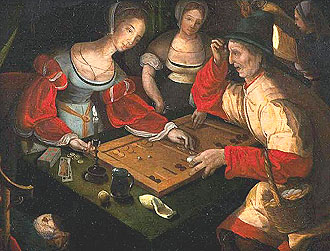|
| Magriel's NYT Columns |
 A player will sometimes make an unusually bold or aggressive move in a bid to turn around a losing game. If successful, he will be immediately applauded for his courage.
A player will sometimes make an unusually bold or aggressive move in a bid to turn around a losing game. If successful, he will be immediately applauded for his courage.
In many positions, however, the best winning strategy requires a conservative waiting play. Because such a play cannot instantly yield dramatic results, its value is easily overlooked. But for the experienced player, knowing when to be patient is just as important as knowing when to be courageous.
In the diagrammed position, White has already doubled and now has the superior position: Not only has White built a strong home board, but he is also far ahead in a running game. In order to win, Black must stop White from coming home safely.
|
| Black to play 6-4. |
The natural play with the 4 is 18/14, bringing a builder to bear on Black’s outfield. Although White will have no direct shots at Black (because White must first reenter), White will still have many indirect return shots (12 chances out of 36). If White hits one of these shots, then Black, with a second man open, will be in grave jeopardy of being gammoned.
Alternatively, Black might also consider playing 13/7*/3, hitting and continuing on with the same man. This leaves a direct 3-shot (13 chances out of 36), but at least avoids playing with two blots. Still, the risk of being hit is unacceptably high.
As a third, more conservative choice. Black might hit and then play 6/2 with the 4. This play reduces the number of immediate return shots (6 chances out of 36), but is even less satisfactory. By awkwardly putting a third man on the 2-point, Black effectively takes a man out of play. Indeed, Black’s position is now so poor that he will be unable to contain White without taking great additional risks in the next few rolls.
Instead of just considering how to play the 4, Black should reevaluate the overall position. The correct strategy is to ignore White entirely this turn, and play 13/9/3, not hitting.
The immediate hit prematurely forces a confrontation with White for which Black is not yet prepared. White’s strong home board will remain a constant threat. By contrast, the only point Black has so far acquired is his 2-point, which may, in fact, be a liability. Thus, by hitting, Black first risks being destroyed by an immediate return shot, and then the best he can hope for is a struggle on unfavorable terms to contain White.
By exercising restraint and allowing White to run, Black is not giving up. Rather, Black gives himself much needed time to strengthen his home board without hindrance. Black fully expects that White will leave additional shots as he moves his men around the outfield and attempts to clear the 12-point. Later, when Black hits a shot, he will probably have a winning position.
Note that 18/8 is a reasonable alternative, which also postpones a confrontation. 13/9/3 is better, because it starts the 3-point and so enables Black more quickly to build up his home board. Also 18/8 suffers from the defect of removing Black’s spare man from the 18-point. This spare man allows Black to hit from the 18-point without giving it up.
Rollout
 Tom Keith 2013 |
|
Money play Black owns 2-cube Black rolls 6-4 1296 games with VR Checker play: 2-ply Cube play: 3-ply Red |
| 6-4: | Game | G | BG | Equity | ||||
| 1 | 18/8 |
W L |
.3579 .6421 |
.0297 .0534 |
.0007 .0017 | −0.1928 |

| |
| 2 | 13/3 |
W L |
.3560 .6440 |
.0367 .0613 |
.0005 .0017 | −0.2009 | (0.0081) | (c) |
| 3 | 13/7*, 6/2 |
W L |
.3772 .6228 |
.0596 .1631 |
.0012 .0046 | −0.2061 | (0.0133) | (b) |
| 4 | 13/7*/3 |
W L |
.3704 .6296 |
.0724 .2055 |
.0016 .0052 | −0.2622 | (0.0694) | |
| 5 | 18/14, 13/7* |
W L |
.3741 .6259 |
.0650 .2237 |
.0019 .0072 | −0.2805 | (0.0877) | (a) |

|
|

